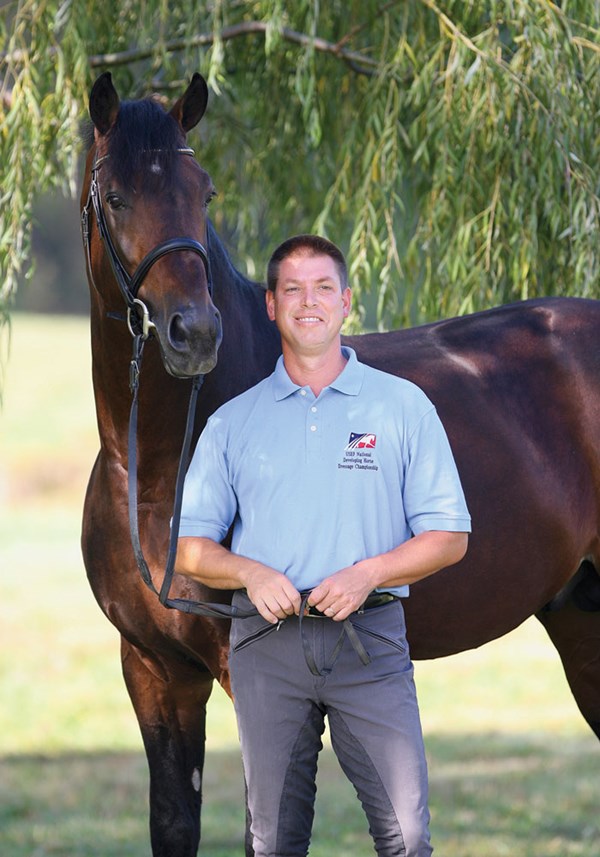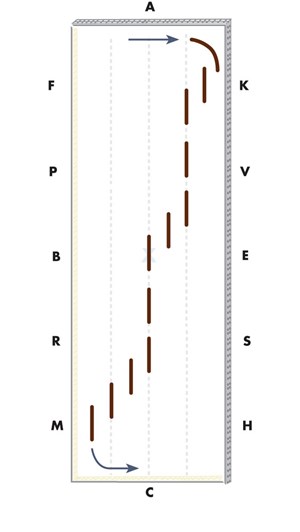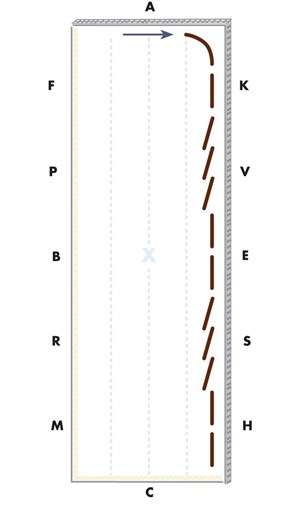I believe you can bring out the best in your dressage horse by building his confidence. Horse training should be like coaching. Both build confidence, set a high standard and bring out the best in a player. And it’s the same whether that player is a kid, a rider or a horse. (To read more about coaching your horse to success, click here.)
In this article, I would like to share the training philosophy and techniques that I have found to be especially effective for building a horse’s confidence. A confident horse blossoms with training and grows more expressive in his gaits as his training progresses. It is our job as riders and trainers to help our horses develop their minds and bodies in a positive way.

Get His Body in the Game
To get a horse’s body in the game, I focus on the basics. I often see riders who miss the importance of the basics and who try to perfect the test movements too soon. The basics are not about doing Training Level forever. The basics are about coaching your horse to be completely supple—to work fully though his back and body.

So how do we develop a more supple horse? We teach him to bend, move laterally, go forward and come back. Our goal is to develop a horse that is ready and available to go north, west or east at any moment. I like exercises that intersperse straightening with bending, and going forward with collecting. When you dwell too long on a lateral movement or collect too much, your horse will tire physically and will look for ways to resist the work. When you train by changing from bending to straightening, from lateral to forward and riding in and out of collection, you develop a ready, responsive horse.
Lateral Suppleness
Here are some of my favorite exercises for developing lateral suppleness:
1. Ride a three- or four-loop serpentine, but make it with square corners and straight lines. Make the corners deep by bending your horse and then straightening him completely before the next turn. Straightening is as important as bending. When you straighten often, you release the back before it becomes stressed. For example, if a horse is worried about bending left, you can make one left turn and then straighten him. The horse gains confidence because he was able to complete the task. He experienced the sensation of moving his back in a new way, and now he is safely traveling straight again.

2. Ride a leg yield off the rail three to four steps, then ride forward toward the short side for three to four steps. Now leg yield over three to four more steps and repeat until you reach the short side. How far you move across the arena will depend on the flexibility of your horse. Don’t be too concerned about how much he can go sideways. Focus on the quality of his steps with the hind legs. Does he articulate his hind legs to step over like a dancer? Or does he shuffle or cruise away from your leg? You can show him how to release his back by teaching him to move promptly away from your leg and then asking him to straighten and push through with his hindquarters. The transitions from straight to sideways will teach him to stand up and step actively under with the hind legs.

3. You can ride a similar version of this exercise with shoulder-in. Sometimes horses (and riders) confuse slowness with collection. This is a great exercise to keep the energy and responsiveness fresh. Ride up the long side and ask for three to four steps of shoulder-in, then straighten and ride actively for three to four steps down the rail. Crisply enter, exit, enter, exit the shoulder-in all the way down the long side.
Longitudinal Suppleness
The horse also becomes supple with work that lengthens and compresses his body longitudinally. Here are some of my favorite ways to develop longitudinal suppleness:
1. When you have a nice big, pushing canter, you can half halt and ask the horse to carry for a few strides. After you half halt, lighten your contact and follow the horse’s motion with your hands and seat so he does not feel blocked. Ask your horse to carry on the hind legs for only a few strides. You want your horse to feel confident—not overfaced—about his ability to collect. Ride forward and upward out of the collection so that you instill good habits for the future. Always start with a good quality (supple and balanced) trot or canter before asking for steps of collection.
2. If your horse is confused about how to lengthen or extend his trot, ask for a lengthened trot all the way around the arena. Take as many laps as you need and ride like you are “headed to Houston!” At first he will experiment by speeding up. Instead, encourage him to move out in a better tempo by aiding him with your legs and moving your seat in longer strokes. If he breaks to canter, just bring him back to trot and keep asking. Keep going until you feel him try longer rather than faster strides. Relax your leg aids, keep moving with him and praise him so he understands this is the right idea.
3. A good stretchy trotis rewarding for the horse and a great contact-quality test for the rider. If your horse does not understand stretchy trot, show him how to balance from his withers instead of with his neck. First lead him onto a circle with the inside rein. Now pick up the outside rein and ask him to look a bit to the outside. When you feel him release his withers, give the inside rein. Now allow with the outside rein.

Working Through Back Issues
Suppleness in the back is the most important basic you can give your horse. When a horse is not supple in his back, it’s a big deal for him. Horses store a lot of emotion in their backs. If you have ever hurt your back, you know how painful it can be. It occupies your every thought.
How do you know if a horse’s back is not supple? The symptoms can be subtle or explosive. A young horse may buck or rear when you apply your leg to go forward or sideways. An older horse may comply with your requests, but will feel stiff, tight, lazy or rushed. The neck is an extension of the back, so if the neck is braced or stiff or tilted or curled, those are clues that you have a suppleness problem in the back. Horses that are dull to the leg are usually stiff in the back, too, because the rider has been restraining with the reins while giving leg aids. Train your horse to go promptly from leg aids while making sure you allow him to go with your hands. If your horse tries to rush or barge through the bridle, you can use the reins to make a correction, but as soon as he slows, go with him again without a trace of restraint.
Use the suppling–straightening exercises suggested in this article to help your horse learn to move bigger through his back. Ask for a little bit at a time. You may not be able to touch your toes on your first trip to the gym, but if you work at it consistently but gently, your range of motion will improve—and so it is with the horse.
Get His Head in The Game
Now that your horse is physically responsive and supple, you have his attention. How do you make the most of it? Your horse is the player and you are his coach. You are there to help him be successful. As a good coach, you make him feel proud of his strengths. You keep him on his toes by asking questions, guiding him through new or difficult movements and giving him tips on how to improve his weak areas. You help him get fit, teach him the rules of the game and establish the boundaries. Ultimately, you encourage him to express himself and to be special. Here are some specific ways to put this approach into action:
Communicate with clarity, not diplomacy. Horses are confident when the rules of the game are clearly defined. Give a clear aid and expect a clear response. That’s clarity. If you don’t get a response or you get the wrong one, coach the horse to help him find the correct response. Riders who nag or just hope the horse understands may think they are being kind and diplomatic, but from the horse’s point of view, they are being vague and confusing.

While it is OK to make a point with your aids, you have to allow the consequence. Your horse has the right to react. Don’t prevent mistakes. Let him learn and then try again. Beautiful riding is a dialog, a conversation between the horse and rider. Niggling aids make a dull horse. Aids that micromanage make a mechanical horse. Think of it this way: If you control and dominate a conversation, you lose the interest of your partner. When your partner can give feedback, he will feel invested in what you are creating together. He will feel confident that his input is valued. When the horse is with you, show your appreciation by riding quietly with a following seat and light contact. In this way, he will develop expression and joy.
For a horse that is mentally unsettled by his surroundings, step up and coach him through it. Redirect a looky or spooky horse’s attention by asking him little questions: Are you staying in front of the leg and maintaining the rhythm? Can you turn now? Can you flex to the inside? Transmit confidence by staying open in your position and keeping the rhythm in your seat with legs and hands relaxed.
I like to use a horse’s highlights to build confidence and make the work fun. When a horse performs his highlight move, he feels confident and proud. If you are not sure what your horse’s highlights are, notice what he does quite well. Highlights are often whatever feels effortless to the horse. These moments of prowess will build his confidence.
You can use highlights for inspiration or as a reward. For example, start with a highlight and then take that confidence to something your horse finds difficult. Reward progress made in a weak area by having fun with a highlight move. Highlights can also be used to improve another area. For example, a medium trot can lend sparkle to an ordinary trot. A few steps of piaffe can help a Grand Prix horse close up his frame and improve his agility.
When we do great work we feel inspired. I think it’s the same for the horses. Once your horse is supple to your aids, don’t be satisfied with the pleasant picture you have created. Ask for a bit more sparkle. Play with a fun movement. Now that you have earned the right, take this opportunity to make it special.
Positive Training When the Going Gets Tough
Is it possible to always train in a positive way? I think so. I don’t ignore or avoid problems, but I don’t ever attack problems. I understand that 90 percent of the time an issue comes from a weakness in the basics. To attack a training issue is not fair. I make a weakness a bit better, then I go on to work on a highlight to keep the horse happy. It’s our job to coach our horses in mind and body. Help them find a way to be suppler. I tell my students, if the horse is stuck, you don’t have a right to expect whatever movement you are expecting. When do you have the right? You have earned the right when you have developed a horse that is forward-thinking, supple and confident. Once you truly have the right, you can’t go wrong.
There will be times when you challenge your horse physically during training. Always find a way to return to a place that restores your horse’s inner peace. Extensions, lots of leg-crossing and abrupt transitions are particularly physically stressful. Signs that you are asking too much include champing at the bit and gaits that are degrading—becoming quick, choppy or impure. Forcing, overtraining or expecting too much too fast leads to injury or rebellion. If your horse is upset to the point of refusing, you are asking too much. If it seems impossible to improve your horse’s suppleness to your aids, then make sure his physical well-being is OK. Consult with your horse’s veterinarian, farrier, dentist, saddle fitter and other caregivers.
Scott Hassler grew up eventing, driving and show jumping. After he decided to specialize in dressage, he trained with masters such as Herbert Rehbein, Harry Boldt and Michael Klimke in Germany. He developed Hilltop Farm, trained more than 25 horses to Grand Prix and is a member of the International Dressage Trainers Club. In 2005, recognizing the need to inspire more trainers to take on the growing realm of young-horse development, he created the annual Young Dressage Horse Trainers’ Symposium and was appointed USEF Young Horse Dressage Coach. Since 1999, he has been on the USEF Dressage and Breeding committees and he has chaired the USDF Sporthorse Committee since 2001. Visit HasslerDressage.com.











